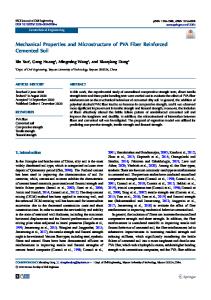Mechanical Properties and Microstructure of Lime-Treated Red Clay
- PDF / 873,889 Bytes
- 8 Pages / 595 x 786 pts Page_size
- 71 Downloads / 378 Views
pISSN 1226-7988, eISSN 1976-3808 www.springer.com/12205
DOI 10.1007/s12205-020-0497-0
Geotechnical Engineering
Mechanical Properties and Microstructure of Lime-Treated Red Clay Lijie Chen
a
, Xuejun Chen
a
, He Wang
b
, Xiang Huang
a
, and Yu Songa
a
College of Civil and Architecture Engineering, Guilin University of Technology, Guilin 541004, China State Key Laboratory for Disaster Prevention & Mitigation of Explosion & Impact, Army Engineering University, Nanjing 210007, China
b
ARTICLE HISTORY
ABSTRACT
Received 19 March 2020 Revised 5 July 2020 Accepted 11 August 2020 Published Online 4 November 2020
This research conducted a triaxial test on lime-treated clay with different contents to analyze the effect of mechanical properties. Scanning electron microscope (SEM) and low-field nuclear magnetic resonance (NMR) analysis were used to analyze the effect. X-ray diffraction (XRD) was used to analyze the chemical changes of calcium oxide on red clay. The results show that with the increase of calcium oxide content, the strength increases, and it can be increased by 282% at 200 kPa confining pressure. The calcium oxide in the red clay reacted with the water in the soil to form calcium hydroxide. The alkaline environment will erode the edge of the soil particles and cause pores to become larger. SEM observed that the addition of calcium oxide caused the agglomeration of soil particles and changed the pore structure of red clay. Low-field NMR showed that calcium oxide had a significant effect on the pore structure of red clay. Calcium oxide increased the total pore volume of the soil sample. Calcium oxide had a substantial influence on the three pore distribution ranges, I (1.1 − 11 µm), II (15 − 137 µm), and III (137 − 512 µm). The porosity fitted with shear strength, it negatively correlated with I and III, and positively correlated with II.
KEYWORDS Lime Red clay Microstructure Mechanics Calcium oxide
1. Introduction Since K. Terzaghi proposed the concept of soil structure in 1925, many researcher have conducted further research and found that the microstructure of soil is an essential factor affecting engineering characteristics such as strength and permeability. The macroscopic and microscopic structure of the soil changed significantly, the evolution of pore distribution predicted the change (Tchalenko and Morgenstern, 1967; Tovey, 1980; Delage and Lefebvre, 1984; Al-Mukhtar et al., 1996; Koliji et al., 2010; Oualmakran et al., 2016; Shan et al., 2016; Lv et al., 2018). Alonso et al. (2013) measured and quantitatively analyzed the pore microstructure of dry and wet compacted soil by mercury intrusion porosimetry (MIP). Lin and Cerato (2015) used scanning electron microscopy (SEM) to observe the microscopic characteristics of expansive soils and explained their micromechanical behavior through microscopic traits. Most of these studies used MIP and SEM to analyze the pore structure characteristics of the soil. However, the main problem of the application is that the MIP test tube is small in size
Data Loading...











